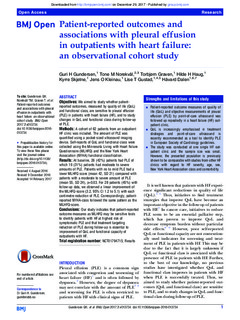| dc.contributor.author | Gundersen, Guri Holmen | |
| dc.contributor.author | Norekvål, Tone M. | |
| dc.contributor.author | Graven, Torbjørn | |
| dc.contributor.author | Haug, Hilde Haugberg | |
| dc.contributor.author | Skjetne, Kyrre | |
| dc.contributor.author | Kleinau, Jens Olaf | |
| dc.contributor.author | Gustad, Lise | |
| dc.contributor.author | Dalen, Håvard | |
| dc.date.accessioned | 2018-01-02T14:35:16Z | |
| dc.date.available | 2018-01-02T14:35:16Z | |
| dc.date.created | 2017-03-22T14:47:47Z | |
| dc.date.issued | 2017 | |
| dc.identifier.citation | BMJ Open. 2017, 7:e013734 (3), 1-8. | nb_NO |
| dc.identifier.issn | 2044-6055 | |
| dc.identifier.uri | http://hdl.handle.net/11250/2474137 | |
| dc.description.abstract | Objectives We aimed to study whether patient-reported outcomes, measured by quality of life (QoL) and functional class, are sensitive to pleural effusion (PLE) in patients with heart failure (HF), and to study changes in QoL and functional class during follow-up of PLE.
Methods A cohort of 62 patients from an outpatient HF clinic was included. The amount of PLE was quantified using a pocket-sized ultrasound imaging device. Self-reports of QoL and functional class were collected using the Minnesota Living with Heart Failure Questionnaire (MLHFQ) and the New York Heart Association (NYHA) functional classification.
Results At baseline, 26 (42%) patients had PLE of which 19 (31%) patients had moderate to severe amounts of PLE. Patients with no to mild PLE had a lower MLHFQ score (mean 42, SD 21) compared with patients with a moderate to severe amount of PLE (mean 55, SD 24), p=0.03. For 28 patients (45%) with follow-up data, we observed a linear improvement of the MLHFQ-score (3.2, 95% CI 1.2 to 5.1) with each centimetre reduction of PLE. Correspondingly, patient-reported NYHA-class followed the same pattern as the MLHFQ-score.
Conclusions Our study indicates that patient-reported outcome measures as MLHFQ may be sensitive tools to identify patients with HF at highest risk of symptomatic PLE and that treatment targeting reduction of PLE during follow-up is essential to improvement of QoL and functional capacity of outpatients with HF. | nb_NO |
| dc.language.iso | eng | nb_NO |
| dc.publisher | BMJ Publishing Group | nb_NO |
| dc.relation.uri | http://bmjopen.bmj.com/content/7/3/e013734 | |
| dc.rights | Navngivelse-Ikkekommersiell 4.0 Internasjonal | * |
| dc.rights.uri | http://creativecommons.org/licenses/by-nc/4.0/deed.no | * |
| dc.title | Patient-reported outcomes and associations with pleural effusion in outpatients with heart failure: an observational cohort study | nb_NO |
| dc.type | Journal article | nb_NO |
| dc.type | Peer reviewed | nb_NO |
| dc.description.version | publishedVersion | nb_NO |
| dc.source.pagenumber | 1-8 | nb_NO |
| dc.source.volume | 7:e013734 | nb_NO |
| dc.source.journal | BMJ Open | nb_NO |
| dc.source.issue | 3 | nb_NO |
| dc.identifier.doi | 10.1136/bmjopen-2016-013734 | |
| dc.identifier.cristin | 1460389 | |
| dc.relation.project | Norges forskningsråd: 237887 | nb_NO |
| dc.description.localcode | Copyright 2017 the Author(s). Published by the BMJ Publishing Group Limited. This is an Open Access article distributed in accordance with the Creative Commons Attribution Non Commercial (CC BY-NC 4.0) license, which permits others to distribute, remix, adapt, build upon this work non-commercially, and license their derivative works on different terms, provided the original work is properly cited and the use is non-commercial. See: http://creativecommons.org/licenses/by-nc/4.0/ | nb_NO |
| cristin.unitcode | 194,65,30,0 | |
| cristin.unitcode | 194,65,25,0 | |
| cristin.unitname | Institutt for nevromedisin og bevegelsesvitenskap | |
| cristin.unitname | Institutt for sirkulasjon og bildediagnostikk | |
| cristin.ispublished | true | |
| cristin.fulltext | original | |
| cristin.qualitycode | 1 | |

